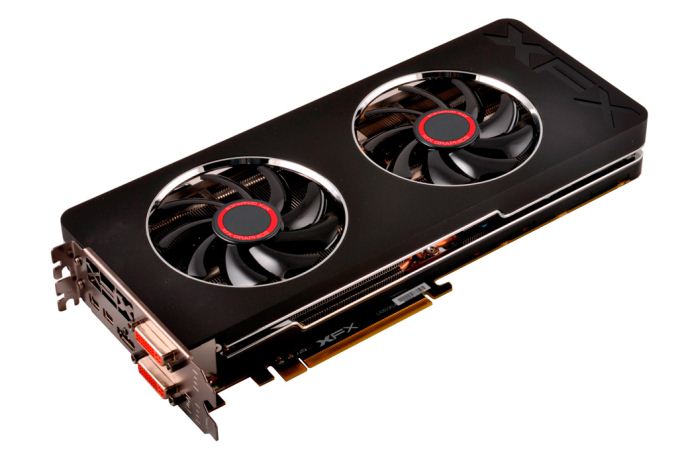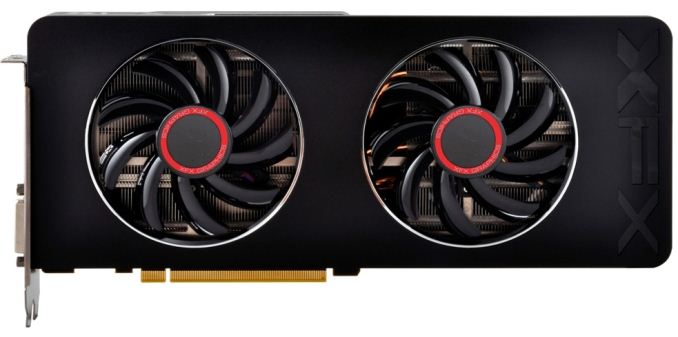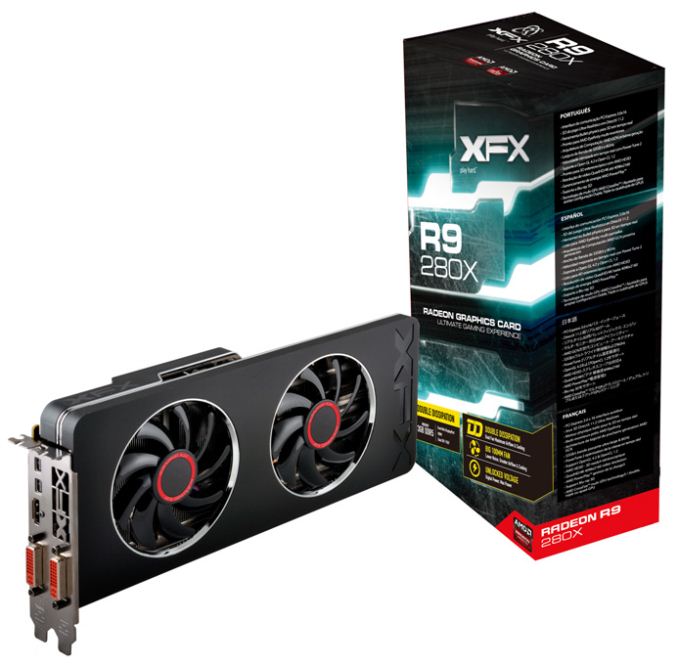The Radeon R9 280X Review: Feat. Asus & XFX - Meet The Radeon 200 Series
by Ryan Smith on October 8, 2013 12:01 AM ESTXFX Radeon R9 280X Double Dissipation
The first of our R9 280X cards is our reference-like sample, XFX’s Radeon R9 280X Double Dissipation. The R9 280X DD is XFX’s sole take on the 280X, utilizing a new and apparently significantly revised version of XFX’s Double Dissipation cooler, and paired with a 280X operating at the 280X’s reference clocks of 850MHz core, 1000MHz boost, and 6GHz RAM. Since there isn’t an overclock here, XFX will primarily be riding on their cooler, build quality, and other value add features.
Diving right into the design of the card, the R9 280X DD is a fairly traditional open air cooler design, as is common for cards in this power and price range. This basic design is very effective in moving large amounts of heat for relatively little noise, making the usual tradeoff of moving some of the cooling workload onto the system’s chassis (and its larger, slower fans) rather than doing the work entirely on its own.
In XFX’s case this is a new design, having forgone their older Double Dissipation design that we first saw on their 7970BEDD back in 2012. What’s changed? Without going into minute details, practically everything. At first glance you’re unlikely to even recognize this as an XFX card due to the fact that this is the first such product from XFX using this design, which aesthetically looks almost nothing like their old design.
First and foremost XFX has gone for the oversized cooler approach, something that’s become increasingly common as of late, equipping the card with one of the larger coolers we’ve ever seen. At 100mm in diameter the two fans on XFX’s design are among the biggest we’ve ever seen, pushing the card to just over 11.1 inches long while causing the heatsink and shroud to stand about 0.75” taller than the board itself.
Drilling down, XFX is using a two segment heatsink, the combined length of which runs the complete length of the card. Providing heat conduction between the GPU and the heatsink is a set of 6 copper heatpipes mounted into a copper base plate. 4 of these heatpipes run towords the rear of the card and the other 2 to the front, perpendicular to XFX’s vertical fin heatsink. Meanwhile cooling for the various discrete components on the board, including the memory, is provided by a separate cut-out baseplate that covers most of the card. There isn’t any kind of connection between the baseplate and the heatsink proper, so it’s the baseplate and any airflow over it that’s providing cooling for the MOSFETs it covers.
Moving on to XFX board, it looks like XFX isn’t doing anything particularly exotic here. XFX is using their standard Duratec high-end components, which includes using solid caps and chokes (typical for all cards in this power category) along with their IP-5X dust free fan. A quick component count has us counting 7 power phases, which would be the reference amount for a 280X, meaning we’re looking at 5 phases for the GPU, and another 2 phases for the memory and I/O.
Meanwhile for I/O XFX implements the common Radeon display I/O configuration of 2x DL-DVI, 1x HDMI, and 2x Mini DisplayPort 1.2. All the while external power delivery is provided by a set of 6pn + 8pin power connectors, as to be expected for a 250W card. With that in mind XFX’s design should have at least some overclocking headroom, but XFX doesn’t provide any overclocking software so you’ll need to stick with Catalyst Overdrive or 3rd party utilities such as MSI Afterburner.
Finally, as a Double Dissipation product the 280X DD is covered by XFX’s lifetime warranty policy, contingent on registering the card within 30 days of purchase. Interestingly XFX remains one of the few board partners that still offers any kind of lifetime warranty, making them fairly exceptional in that regard. As for pricing we’re listing the XFX card at $329 at the moment, though there is still some confusion over whether that’s the final price or not as our XFX rep seemed unsure of that. As is sometimes the case in this industry, we get the impression that they were waiting to see what other manufacturers were going to charge, in which case we suspect the actual launch price will be lower than that. We’ll update this article once we have final pricing information available.













151 Comments
View All Comments
Galidou - Saturday, October 12, 2013 - link
If he really has to whine about high end video card prices, he's new to this because many generations before, the top of the line was often sold for 800$. Anyway, if you simply run 1080p(which most of us does) you can be totally satisfied with a 150-300$ video card and two or three graphical options not maxed(you won't notice it unless you stop playing to just look at the graphics) which is quite different from older generations where you had to pay big bucks to run at higher resolution/graphical settings.I bought a 660ti for 300$ when it came out a year ago and I still run everything at very high/max settings in 1080p PERFECTLY. No reason to whine at all nowadays unless you're a kiddo that is new to the gaming industry and pc gaming gear.
Etern205 - Monday, October 14, 2013 - link
Many generations before top of the end graphic cards like ATi Radeon 9700 Pro, the best card of its time cost $300, and the 2nd best, ATi Radeon 9500 Pro cost just $200.High-end card is the past don't cost a arm and a leg, you can get one and still have enough to feed yourself for a week. Now they cost a arm and a leg, where you have to starve yourself for a month just to have enough to buy one.
hansmuff - Tuesday, July 14, 2015 - link
The Matrox MGA Millennium 4MB was $549 at launch and became a somewhat legendary performer in DOS VESA modes. That's 1995.bwat47 - Monday, December 9, 2013 - link
Yeah, a 280x was a steal for 299, excellent card.Anand Lal Shimpi - Tuesday, October 8, 2013 - link
We're working on it :) AMD gave Ryan very little time to go through four new cards, it's being added in real time here.Sunrise089 - Tuesday, October 8, 2013 - link
No disrespect Anand, but 'special relationship' with AMD notwithstanding, if they're asking you to have your article up at midnight for a launch but you can't even have product specs available by then I worry the advertising side of things is encroaching a bit into the editorial side.zanon - Tuesday, October 8, 2013 - link
Have to agree. I've always appreciated in the past that Anandtech would take the time to do reviews right, even if it very, very often meant that they'd come in days or more after the early rush. We've already got plenty of early rush stuff on the net that is of poor quality, please do not go that route. Just do a pipeline piece with early conclusions as you have before. You've got this going up across all twitter/rss/whatever feeds, everyone sees it and comes in, and it's a really poor showing.If AMD tells you to hit a certain launch window please kindly tell them to get stuffed or get your hardware earlier next time. If you're letting them rush you to their own schedule that feels like a really bad sign.
Anand Lal Shimpi - Tuesday, October 8, 2013 - link
See the above response, but I'd add: you don't have to worry about us going down the path of lowest common denominator. I hardly think that what was posted here at midnight was even close to fitting that description.Anand Lal Shimpi - Tuesday, October 8, 2013 - link
er below response :)chizow - Tuesday, October 8, 2013 - link
Easy guys, it's happened with other non-AMD reviews too in the past, I know other staff writers will often chip in and help with some aspects of the reviews, like tables and graphs, and sometimes the entire piece comes together online in real-time. It's like a big group project or presentation, sometimes it just doesn't go off perfectly on such short deadlines.